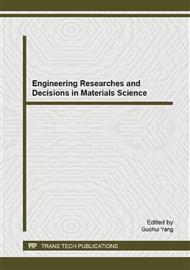p.44
p.51
p.58
p.63
p.69
p.75
p.80
p.86
p.92
Preparation and Properties of Yttrium Doped Barium Cerate (BaCe1-xYxO3-δ)
Abstract:
Yttrium doped barium cerate is considered a promising electrolyte material for solid oxide fuel cell applications due to its excellent proton conductivity. The proton conductivity characteristics of the ceramic material can be influenced by the different synthesis processing parameters. This study aimed to obtain yttrium doped barium cerate BaCe1-xYxO3-δ (x = 0.15, 0.20) using a sol-gel modified Pechini method. The phase formation and surface morphology of the yttrium doped barium cerate were investigated using x-ray diffraction and scanning electron microscopy. The thermal decomposition of the calcined ceramic material was examined using thermogravimetric analysis. Diffraction analysis confirmed the formation of perovskite crystalline structure with the presence of secondary phase yttrium doped ceria. Larger grain size with homogeneous distribution and coalescence was observed in the sintered BaCe0.80Y0.20O3-δ.
Info:
Periodical:
Pages:
69-74
Citation:
Online since:
April 2015
Authors:
Price:
Сopyright:
© 2015 Trans Tech Publications Ltd. All Rights Reserved
Share:
Citation:


